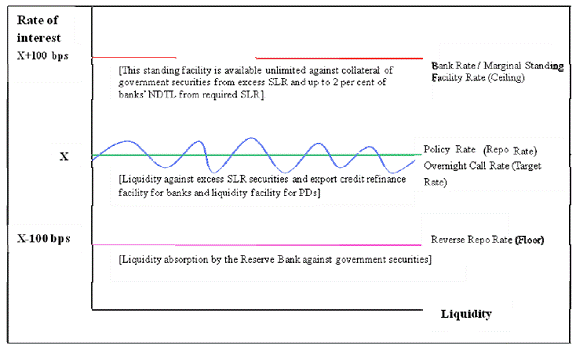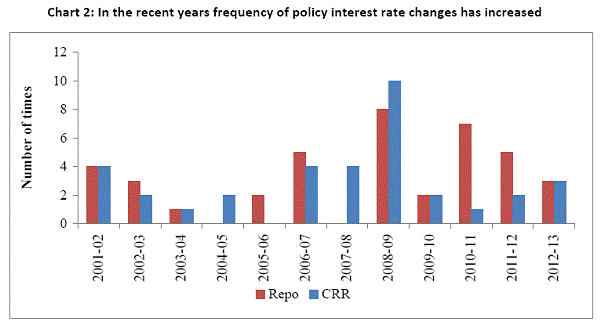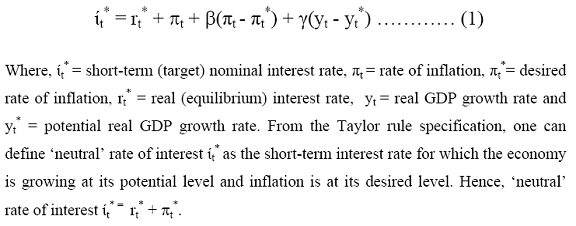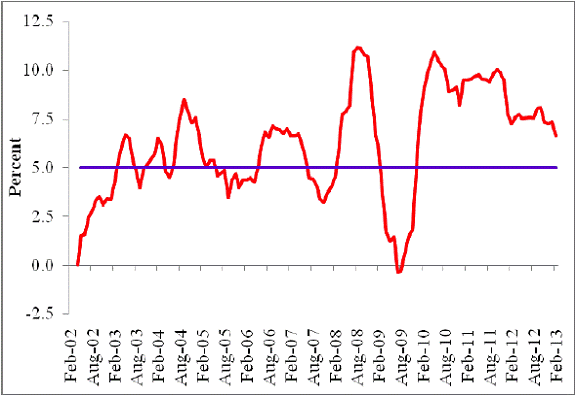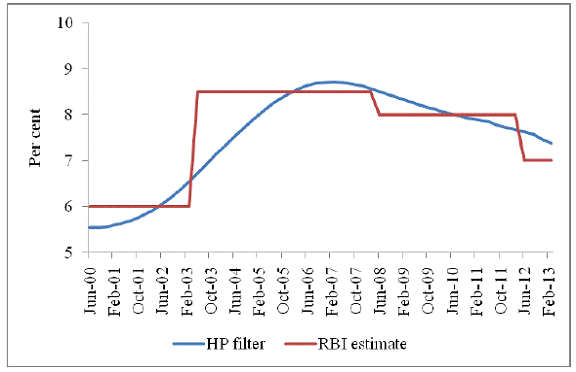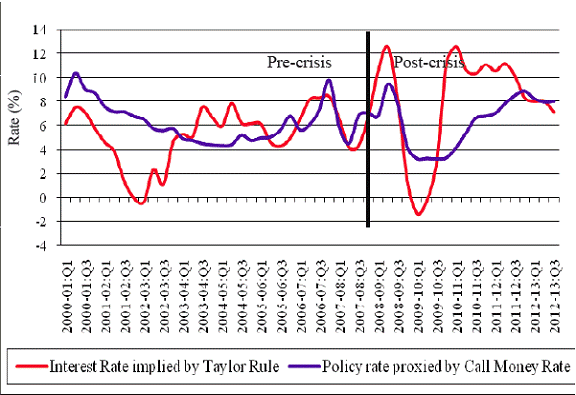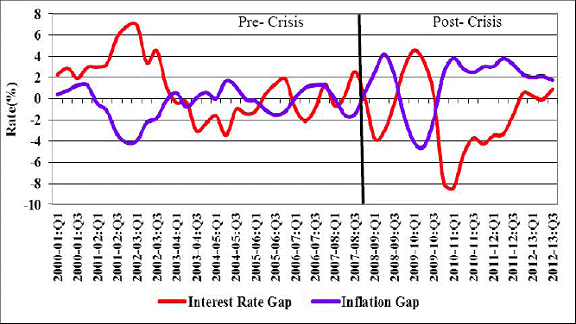 IST,
IST,


Efficacy of Monetary Policy Rules in India
Shri Deepak Mohanty, Executive Director, Reserve Bank of India
delivered-on মাৰ্চ 25, 2013
I thank Professor Pami Dua for the opportunity to interact with this distinguished gathering of professors and young scholars.The Delhi School of Economics has a formidable reputation world over in teaching and research in economics. I will be speaking on the subject of monetary policy rules, not only because it relates to my area of work, but it offers considerable scope for research. My scheme of presentation is as follows. First, I begin by giving you a snapshot of the evolution of monetary framework in India to contextualise how short-term interest rate has emerged as the key operating objective of monetary policy. Second, I briefly focus on the debate on rule versus discretion in the conduct of monetary policy. Third, I present simple Taylor rule estimates for India covering the recent period of 2001-2013 reflecting greater use of interest rate as an instrument of monetary policy. I will conclude with some thoughts on the way forward. Monetary policy operations Let me briefly highlight the evolution of monetary policy operating framework in India, to place our discussion on interest rate rules in perspective. In India, as in most countries, monetary policy framework has evolved in response to and as a consequence of financial developments, openness and shifts in the underlying transmission mechanism. The evolution of monetary policy framework in India can be seen in phases. In the formative years during 1935–1950, the focus of monetary policy was to regulate the supply of and demand for credit in the economy through the bank rate, reserve requirements and open market operations (OMO). In the development phase during 1951–1970, monetary policy was geared towards supporting plan financing. This led to introduction of several quantitative control measures to contain consequent inflationary pressures. While ensuring credit to preferred sectors, the bank rate was often used as a monetary policy instrument. During 1971–90, the focus of monetary policy was on credit planning. Both the statutory liquidity ratio (SLR) and the cash reserve ratio (CRR) were used to balance government financing and the attendant inflationary pressure. Subsequently, structural reforms and financial liberalisation in the 1990s shifted the financing paradigm for the government and commercial sectors with increasingly market-determined interest rates and exchange rate. By the second half of the 1990s, in its liquidity management operations, the Reserve Bank was able to move away from direct instruments to indirect market-based instruments. Starting in April 1999, the Reserve Bank introduced a full-fledged liquidity adjustment facility (LAF). It was operated through overnight fixed rate repo and reverse repo in November 2004. This process helped to develop interest rate as an instrument of monetary transmission. This framework was reinforced in May 2011 when the weighted average overnight call money rate was explicitly recognised as the operating target of monetary policy and the repo rate was made the only one independently varying policy rate (Mohanty, 2011)1. Chart 1: The new LAF framework is based on The new operating framework illustrated in Chart 1 with the modified LAF assigns a greater weight to the interest rate channel of monetary transmission. This means that once the Reserve Bank changes policy repo rate, it should quickly impact the overnight interest rate which is the operational rate and then transmit through the term structure of interest rates as well as bank lending rates. Increasing importance of this channel was also evident from the mix of instruments of policy actions. Over the years, in comparison with CRR, the use of interest rate instruments such as the Repo rate by the Reserve Bank has been more frequent, except for the year 2008-09, which was the peak of the global financial crisis (Chart 2).
Rule versus discretion As the Reserve Bank has started explicitly targeting overnight interest rate as the operational objective with the instrument of policy repo rate, there are relevant questions those arise: How that interest rate should be determined? Should it broadly follow a rule or should it be based on the central bank’s discretion? The debate about rule versus discretion is as old as monetary economics. This issue received added impetus as the monetary system transited from gold standard to fiat money. When Kydland and Prescott (1977) in their seminal article presented the time inconsistency argument in favour of rules, the debate became even sharper2. Subsequently, Taylor (1993) demonstrated how even in the practical world of monetary policy making, the monetary policy reaction function could be modeled as predetermined rules with superior policy outcome3. Let me briefly touch upon the pros and cons of rule-based monetary policy before turning to the formulation of Taylor rule. A number of reasons have been advanced in the literature as to why rule-based monetary policy could be more effective. First, a rule towards a credible commitment by the central bank to maintain price stability can reduce the inflation bias from monetary policy. Second, rules enhance economic efficiency by reducing uncertainty about future policy. Third, rules help policymakers avoid pressures from special interest groups and facilitate action consistent with long-run goals. Fourth, rules facilitate communication, promote transparency and increase accountability. Similarly, there are arguments against application of rules. First, the economic system is too complex to be characterized by any rule. Second, the same rule may not work over the business cycle. Third, rule-based policy reduces the flexibility to respond to exogenous shocks. Fourth, rules do not allow for policy surprises which may be desirable for policy effectiveness under certain circumstances. Fifth, rules are ill suited to developing economies characterized by underdeveloped financial markets and rapid structural transformation. In practice, it is difficult to come across central banks, which explicitly spell out their policy rules. However, for modern central banks, empirical assessments and policy evaluations are increasingly based on rules ever since Taylor’s influential paper. In empirical work, original Taylor rule is modified and extended in a variety of ways for adapting to specific country set up and evolving monetary framework. These include forward-looking Taylor rule, Taylor-McCallum type rule, non-linear framework for addressing asymmetric behavior of monetary policy and time-varying nature of its parameters. Taylor rule Taylor rule is an interest rate feedback rule for a central bank for setting short-term interest rates to achieve both its objectives of stabilizing the economy and achieving price stability as economic conditions fluctuate. This could be expressed as:
The rule recommends that short-term interest rate should be changed according to the deviation of inflation from its predetermined target and output from its potential level. Essentially, the combination of inflation and output gap should determine what should be the appropriate policy rate that would return the economy to its potential level without causing inflation.If these goals are in conflict in the sense that inflation is above its target and the economy is growing below its potential or vice versa, the rule provides guidance on how to balance these competing considerations in setting an appropriate level for the policy interest rate. While β and γ could be estimated from data, Taylor assumed those as 0.5 each. In a sense it assigns equal weights to both inflation and growth objectives. This is a reasonable assumption considering that most central banks are concerned both with inflation and growth. These dual objectives are built into many central bank statutes, including that of the US.He also additionally assumed that desired level of inflation for the US was 2 per cent per annum and the equilibrium real policy rate was 2 per cent per annum. Taylor (1993) showed that a simple monetary policy rule, where the US Fed raises the interest rate if inflation rate exceeds a 2 per cent implicit target or if real GDP growth is higher than its potential, describes quite well the actual path of the Fed funds rate between 1987 and 1992. The linear framework of Taylor rule is, however, criticized by many on the ground that central banks have asymmetric preferences for interest rate smoothing depending on the direction of their monetary policy stance. In addition to changes between discretionary and rule-based policy regimes, economic theory provides several reasons for deviating sometimes from a symmetric and linear policy rule framework (Gerlach, 2000)4. An accepted way of representing such behaviour in literature is to assume that actual interest rate it gradually adjusts to the desired rate as: ίt = ρit-1 +(1-ρ) ίt*, where 0 < ρ < 1 captures the observed smoothing of the policy rate by the central bank, i.e., the smoothing parameter. Substituting this in the original Taylor rule formulation in (1), the modified Taylor rule with smoothing takes the form as:
It may be noted that equation (2) is not linear in parameters and hence parameters ρ, α, β and γ are estimated from the observed data by non-linear least square method. Estimates for India In India there has not been much research on monetary policy rules partly because the underlying monetary framework largely relied on direct and quantity based instruments. Moreover, the commercial interest rate structure was highly regulated till recently. In the Indian context, Singh (2010) estimated Taylor rule using annual data for the period 1950-2009 and observed a shift in policy response towards inflation gap since the 1990s.5 Patra and Kapur (2012) estimated a forward-looking exchange rate augmented Taylor rule and found a high degree of interest rate smoothing.6Empirical estimation of Taylor Rule will require a priori determination of three parameters: the desired level of inflation, potential output and equilibrium real policy rate. These parameters are country-specific, and hence need to be estimated. First, in the mid-1980s the Chakravarty Committee (1985)7 had suggested a tolerable level of inflation of 4.0 per cent per annum to facilitate changes in relative prices necessary to attract resources to growth sectors. The Reserve Bank’s current assessment suggests that the threshold level of inflation for India is in the range of 4.4-5.7 per cent, implying a mid-point rate of 5.0 per cent (Subbarao, 2013).8 Drawing on the research in the Reserve Bank, the desired level of inflation rate in terms of year-on-year variation in the wholesale price index (WPI) is assumed at 5.0 per cent. The actual inflation rate, however, has remained above this threshold level in the post-crisis period (Chart 3). Chart 3: Inflation in the post-crisis period
Second, the potential output growth is estimated by using the Hordrick-Prescott (HP) filter. The estimated potential output is broadly comparable to the Reserve Bank’s assessment that India’s potential output may have dropped from 8.5 per cent during the high growth phase of 2003-08 to 8.0 per cent in the post-crisis period to around 7.0 per cent in 2012-13 (Chart 4). Chart 4: Potential output is estimated to have been
Third, the determination of the neutral real policy rate is a complex issue as it is not observed in real time. One way is to derive it from a comprehensive general equilibrium model of the Indian economy. Another simpler, though not very satisfactory, way of deriving it is from the Taylor rule estimate itself.The empirical estimate from the two alternatives of Taylor rule estimated by us suggests it to be in the range of 0.5-0.9 per cent covering a longer period from 2000-01:Q1 to 2012-13:Q3 which encompassed the recent bout of high inflation. The implicitly derived number from the high growth and low inflation phase of 2003-08 works out to 1.1 per cent per annum (Table 1). For the purpose of this exercise we have assumed it to be 1 per cent. Combined with our first assumption of desired level of inflation of 5.0 per cent, it will imply that the neutral nominal policy rate could be assumed around 6.0 per cent per annum. Following these three key assumptions, empirical analysis is done in two stages. In the first stage, we have estimated the Taylor rule from the observed data with and without interest rate smoothing. In the second stage, we have simply used the original Taylor Rule assuming inflation and output gap coefficients at 0.5 each. Our empirical analysis is based on quarterly observations from 2000-01:Q1 to 2012-13:Q3 with average overnight call money rate as the measure of short-term interest rate. The results suggest greater weight on inflation, evident from the level of statistical significance and correctness of the sign of the parameters, in the standard formulation. But interest smoothing becomes dominant in the alternative formulation alongside a significant weight on inflation. In this formulation, although the output gap has the expected sign, it turns out to be statistically insignificant. However, the explanatory power of the equation improves substantially as compared with the standard formulation (Table 2).
Given the estimated neutral rate of interest, desirable inflation rate and potential output growth, we have calculated the level of interest rate implied by the standard Taylor rule with equal weight of 0.5 to both inflation and output gap. The trend in estimated interest rate implied by Taylor rule showed periods of significant departure from the actual call money rate trajectory. But the deviation was more pronounced in the post crisis period which has since been narrowed in 2012-13. Interestingly, there was close correspondence between the implied Taylor rule interest rate and actual overnight call money interest rates during the high growth phase of 2003-08 (Chart 5). Chart 5: Greater divergence in interest rate post-crisis
We also compare another measure of gap: interest rate gap as the difference between quarterly average overnight call rate and interest rate obtained from the Taylor rule, and inflation gap as the difference between quarterly average inflation rate and target inflation (Chart 6). It showed statistically significant inverse correlation which implies that higher the deviation of policy rate from that implied by the simple Taylor rule, higher is the deviation of inflation from its desired level.9 Chart 6: Interest rate gap mirrored inflation gap
Moreover, in the crisis period, the gap had widened which has since narrowed in 2012-13. Additional diagnostics suggested bi-directional causality between the interest rate gap and inflation gap. It is noteworthy that this gap was narrower during the high growth phase of 2003-08. Conclusion Let me conclude. The Taylor rule has been extensively used to understand the interest rate setting behaviour of central banks across the world. Recent empirical work including the simple characterisation I have presented here suggests that a Taylor-type rule could be a useful additional tool in understanding the interrelationship among growth, inflation and policy interest rate as the interest rate channel of monetary transmission strengthens. At the same time, it should be emphasised that Taylor rule has its limitations as exclusive emphasis on interest rates with the neglect of other variables may not be optimal for an emerging market economy like India. In my presentation if I have raised more questions than provide answers, I would have succeeded in my intention. There is a need for further research to enhance our understanding of appropriate interest rate structure which is conducive to price stability in the medium- to long-term. Thank you. * Speech by Shri Deepak Mohanty, Executive Director, at Delhi School of Economics, Delhi, 25th March 2013. The assistance provided by Abhiman Das and Binod Bhoi in preparation of this paper is acknowledged. 1Mohanty, Deepak (2011): “How does the Reserve Bank of India conduct its Monetary Policy?” Reserve Bank of India Bulletin, September. 2 Kydland, Finn and E. Prescott (1977): “Rules Rather than Discretion: The Inconsistency of Optimal Plans”, Journal of Political Economy, 85 (3), 473-492. 3 Taylor, J.B. (1993): “Discretion versus policy rules in practice”, Carnegie-Rochester Conference Series on Public Policy, 39, 195–214. 4 Gerlach, S., (2000): “Asymmetric Policy Reactions and Inflation”, Working Paper, Bank for International Settlements. 5 Singh, Bhupal (2010): “Monetary Policy behaviour in India: Evidence from Taylor-Type Policy Frameworks”, Reserve Bank of India, Staff Study, SS (DEAP): 2/2010. 6 Patra, M. D. and M. Kapur (2012): “Alternative Monetary Policy Rules for India”, IMF Working Paper, No.118, IMF. 7 Reserve Bank of India (1985): Report of the Committee to Review the Working of the Monetary System (Chairman: Sukhamoy Chakravarty). 8 Subbarao, D (2013): “Is There a New Normal for Inflation?” Speech delivered at the Bankers’ Club, New Delhi on March 8, 2013. 9 Correlation coefficient of -0.78 which was statistically significant at 1 per cent. |
||||||||||||||||||||||||||||||||||||||||
পৃষ্ঠাটো শেহতীয়া আপডেট কৰা তাৰিখ:






